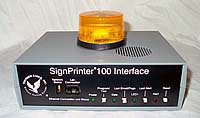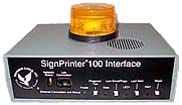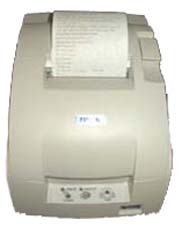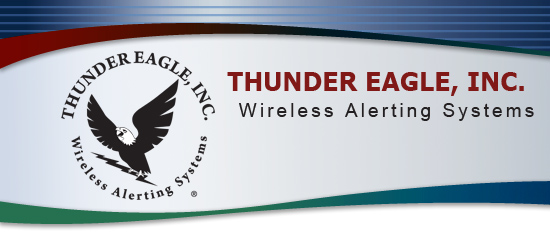
When the National Weather Service sends out emergency alerts, the Alert Eagle®400 (AE400) automatically decodes the messages, matches and translates them and sends them to the FipsSender™ for immediate transmission to signboards, emails, wire text, printers, buzzers and strobe lights.
The AE400 transmits the messages through your LAN/WAN network and the FipsSender™ software to the SignPrinter® Interface (SP100), which outputs the data to LED signboards and printers. Click HERE for a system overview.
How the SP100 works
- Upon receipt of a message, the SP100 beeps 20 times, flashes a strobe light and closes a relay, which turns on the system.
- An LED indicates whether the unit has power.
- The SP100 will send a message back to the FipsSender™ software indicating whether the LED signboard acknowledged the alert.
- The SP100 saves the most recent alert in nonvolatile memory at the remote location for diagnostic purposes.
- Pressing the “Last Alert” button allow you to play back the most recent alert to the LED signboard and to the printer.
- Pressing the Reset button resets the LED signboard to normal messages, turns off the strobe light and opens the relay, turning off the system.
- Pressing the “Test” button closes the relay, turns on the strobe light, starts the alert beep sequence, sends a test message to the LED signboard and printer and flashes the alert LED.
- Each SP100 requires a unique, static IP address.
- The strobe can be set by the user, in software, to turn off between 1 second and 18 hrs after an alert.
Information on the configuration of the web server is located in the customer Login area of this web site.
|

WE110 – Stand-alone Receiver

WE110R-Rack Mount

WE110 Receiver -
AE120 SAME-EAS Decoder

WE105 Receiver -
AE400 SAME-EAS
Decoder
Translates Alerts to Text

MRI-100 MultiRadio Interface

FipsServer Custom Weather Website

SP100 SignPrinter Interface

One Line LED Signboard

Two Line LED Signboard

Rugged Printer

Strobe Light
|







